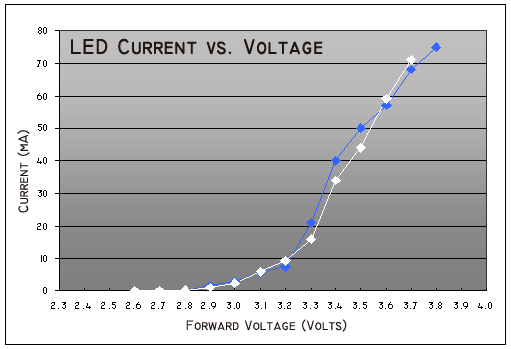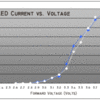I want to use led lights to light up underneath my second level,i have these led bulbs they are 8mm 0.5 w led high power emitting diodes,i have no idea what size resister to use,or besides the resister do i need to use anything else along with the resister ? also i have never done this before can anyone tell me how these things get hooked up,such as do the resisters get hooked up to the positive ,or negative side? my guess would be the positive side. Thanks for any help you can give me.
Replies sorted oldest to newest
LED's only work in one direction, if the polarity is reversed like any diode current will not flow. As for the dropping resistor I would put it on the input side of the device because you wont to drop the voltage before it hits the PN junction.
All that said, make sure that the voltage you apply to the diode dose not exceed the diodes rating. That is why a resistor is used, to protect the diodes PN junction. Remember voltage is force, thus only is the level of electrical force being applied to a device. Current flows and that is what the diode really blocks.
Have Fun.
gg1man,so i would put the resister on the positive side ,correct?, I forgot to mention that i am powering these lights from the accessory side of my transformer 12 v.
The resistor goes anywhere in the circuit. Think of electricity like water through a garden hose. Anywhere you put a restrictor valve will have the same effect.
If would just buy LED rope. A 10' length with drivers is less than $20. Just plug into 120 volt outlet.
Thanks John, now i am making some progress,what size resister do i need?,i have no understanding at all on how to figure that out,a lot of this stuff is way over my head,also do i need a bridge rectifier or anything else along with the resister?
Oman, I could buy an led rope but i don't want a lot of lite,just enough to have a different mood,thanks for the suggestion.
It really depends on how you're wiring the lights. The fact that you're using non-standard high power LED's changes things. We need the exact specifications of the LED's as well as exactly how you're going to wire them. I see some series/parallel wiring to keep the power draw reasonable if you're using a lot of these. A .5W white LED would be using 160ma of current, and will require some sort of heatsink to avoid cooking itself, something to consider. I question if you really want to go to the trouble of using these instead of the previously suggested LED rope.
John,you make an excellent point,when i bought these on e-bay they were very cheap,i think i paid $5.00 for a hundred of them,i figured that even if i ruined a lot of these it wouldn't be much of a loss i really bought these to experiment with while learning how to hook them up,i didn't have a specific project in mind,so now i have 100 led's that i will most likely never use,if you can use them you can have them ,for free i would mail them to you,you have helped me in the past with different problems, they are yours if you want them, i will stick with different led's for my project ,i would like to learn how to make up my own led's,it would be interesting to do , let me know if you want them.
Thanks, Jerry M.
Jerry, thanks but I have a bunch of these too. That's how I know exactly what they require. ![]() I wanted bright LED's, but when I got them, I realized they were REALLY bright and also ran REALLY hot.
I wanted bright LED's, but when I got them, I realized they were REALLY bright and also ran REALLY hot. ![]()
Jerry,
This site is a big help in learning about and wiring LEDs.
John H, Thanks for the link ,i have it stored on my computer for future reference.
You are very welcome. Here is some more help. Scroll down to Basic LED help.
What is "diode forward voltage " how is it determined ?
Doug
The Forward Voltage and Reverse Voltage specifications are in the datasheet for the individual LED. Forward voltage is the nominal voltage that the LED operates at when lit at it's rated current. Reverse voltage is the maximum reverse polarity the LED is specified to be able to tolerate.
Typically, the forward voltage of an LED is about 1.8–3.3 volts. A red LED typically drops 1.8 volts, but voltage drop normally rises as the light frequency increases, so a white or blue LED may drop around 3.3 volts.
Note that all LED's require current limiting unless you control the voltage very precisely.
Thanks Gunrunner, but what if someone gives you a bunch of LED's and there's no data info. Just experiment with one, hook it up with a volt meter, raise the voltage until it's bright and use that voltage ? ?
Looking at the brightness of an LED and trying to guess the proper voltage is a very poor way to try to use them. First off, different LEDs have a very wide range of brightness at full rated current. If you have an unknown LED, you have no idea how bright it should be at rated current. Add to the fact that judging the actual light output by eyeball is hardly an exact science. Finally, the LED current will vary very sharply with a very small increase in voltage, so trying to control brightness that way is pretty tricky, and hazardous to the health of the LED. LED's are really current mode devices, and controlling the current is a much better way to use them as a rule.
Consider the following voltage vs. current curve for a typical white LED. Note that at 3.0 volts the current is perhaps 2 ma, but at 3.3 volts you're already at 20ma. So, for 10% of the voltage swing, you've increased the current in the LED by a factor of ten! If you increase the voltage just .2 volts more, you're running at well over twice the maximum current rating of the 20ma LED, that results in a very short life for your LED.
If someone hands me a bunch of LEDs with no data, I assume they're 20ma parts, that is by far the most common current rating. The reverse voltage rating of common LED's is in the 5-7 volt range for the most part as well.
I rarely spend a whole lot of time thinking about trying to squeeze the absolute maximum light out of an LED, I'd rather run them somewhat below their ratings, makes for a practically infinite life.
Consider that my passenger car lighting module delivers a maximum of 50ma constant current, and I typically put 24 LED's on the 12V strips in 8 groups of 3 LED's each into an 18" passenger car. If you calculate the maximum current consumed by each group, it's 6.25ma at 50ma total output of the power module. I rarely run the LED's at anything like that brightness as they are far too bright, I normally end up in the 20-25ma range to light an entire car, that's 2.5 - 3.125ma for each LED.
------------------------ How to ballpark the LED resistor -----------------------------
I take the LED working voltage, you can assume around 2 volts for red and yellow LED's, 2.5 for green, and 3.0 for white or blue. I subtract that from the RMS voltage supply, for DC that's simply the difference, for AC, that's half the voltage times 1.4. That number is multiplied by 50, and that's the minimum value of the current limiting resistor. You can make the resistor larger for less light, which I frequently do for many uses like markers, class lights, etc.
This is probably way more than you wanted to know. ![]()
Attachments
John H, The Trainelectronics link is even more interesting,i am saving this one also,hopefully i can learn something & be able to put together my own led's,i can see by some of the responses on this thread that it can be complicated & you need to have a good understanding of electronics,which i don't have ,but i can see where I can learn enough to do some more simple led wiring,time will tell.
Thanks, Jerry M.






